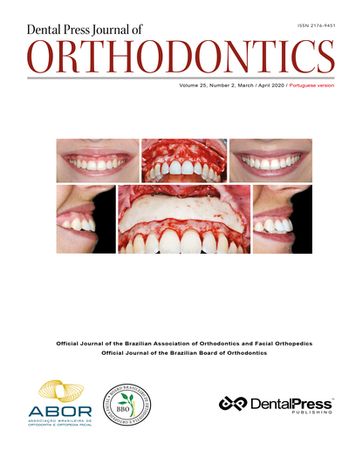Tratamento de Classe III esquelética com assimetria facial utilizando ancoragem esquelética: 4 anos de acompanhamento
Artigo Online
Autores: Tulika Tripathi, Priyank Rai, Shilpa Kalra,







As early as 2007, a paper published in the Clinical Microbiology Reviews on SARS coronavirus infection already warned us that “the presence of a large reservoir of SARS-CoV-like viruses in horseshoe bats, together with the culture of eating exotic mammals in southern China, is a time bomb”.1 In spite of this grave alert, we are currently experiencing one of the most serious pandemias in human history. I believe most of us are still in absolute dismay with this disease, which was first...
Leia mais
Many controversies linger over the role of orthodontics in the treatment of patients with periodontal problems. Over the years, certain published clinical cases have indicated the positive impact of orthodontic intervention in cases of gingival recession in the mandibular anterior region. However, clinical studies with more methodological rigor are still needed. In this context, Danish and German researchers conducted a recent study1 with the aim of evaluating the impact of orthodontic root...
Leia mais
If essential care is thorough, teeth with extensive orthodontically induced dental resorption can have the same endurance as normal teeth. These teeth are subjected to the same disturbances as normal ones, such as dental trauma, dental caries and periodontal disease, all of which are independent of severe dental resorption. Orthodontic retreatments of teeth presenting with extensive orthodontically induced dental resorption must take into consideration that these roots are shorter in length,...
Leia mais
Introduction: Skeletal Class III malocclusion with asymmetry is one of the most difficult problems to correct in orthodontics. A functional shift of the mandible in growing patients may occur accompanying a Class III, due to constricted maxillary arch and occlusal interferences. Studies have indicated that posterior unilateral crossbite develops early and has a low rate of spontaneous correction. It may further lead to development of mandibular and facial asymmetry by growth and displacement...
Leia mais
Objective: Evaluate dental and skeletal changes resulting from the exclusive use of the cervical headgear for 15 ± 4 months in the treatment of patients with Class II division 1 malocclusion. Methods: Differences between the beginning (T1) and immediately after the end of the therapy (T2) with the cervical headgear in growing patients (Experimental Group, EG, n = 23) were examined and compared, during compatible periods, with those presented by a group of untreated individuals (Control...
Leia mais
A healthy 15-year-old boy with anterior open bite, edge-to-edge transverse discrepancy, and Class III skeletal relationship sought a nonsurgical orthodontic treatment. The patient was treated with premolars extraction, a Hyrax expander and intrusion mechanics with vertical elastics. This mechanics allowed for excellent facial and occlusal results. The final occlusion presented Class I molar and canine relationships, ideal overjet and overbite, and straight facial profile. Analysis of the...
Leia mais
Objective: To evaluate facial profile changes promoted by polymethyl methacrylate (PMMA) cement graft to reduce excessive gingival display due to hyperactivity of the elevator muscles of the upper lip during smiling. Methods: Eleven patients (all females, age range: 20 to 43 years) presenting gingival smile that were treated with PMMA cement grafts in a private clinic were selected for this retrospective study. Three angular and ten linear cephalometric facial profile measurements were...
Leia mais
Introduction: Plaque accumulation can cause white spot lesions. Adding nanoparticles to composites can be effective in reducing the number and function of microorganisms. Objective: The aim of this study was to evaluate the antibacterial effects of orthodontic composites containing different nanoparticles on Streptococcus mutans at different times. Methods: Hydroxyapatite, titanium oxides, zinc oxide, copper oxide and silver oxide nanoparticles were prepared at 0.5% and 1% weight...
Leia mais
Introduction: Facial asymmetry associated with unilateral condylar hyperplasia (UCH) is a complicated clinical condition. Objective: The objective of this study was to describe morphological characteristics of the mandible and the temporomandibular joint in patients with facial asymmetry, using computed tomography and 3D reconstruction. Methods: A retrospective observational study was performed with patients displaying facial asymmetry evaluated by single photon emission computed tomography...
Leia mais
Introduction: Class II malocclusion, which has a significant incidence in the population, may compromise facial esthetics and the smile, as well as the masticatory and respiratory functions. Often associated with skeletal abnormalities, it severely affects and compromises quality of life. An accurate diagnosis is fundamental to prepare a treatment plan to correct dental and skeletal anomalies. Objectives: This study discusses treatment alternatives to the correction of Class II division 1...
Leia mais
Introduction: A significant increase in the number of adults in search of orthodontic treatment has raised a new challenge for orthodontists: the need to interact with other specialties to achieve excellent results, particularly when dealing with smile aesthetics and facial balance. Several factors should be considered to respond to their demand: adequate tooth leveling and alignment, individual tooth proportions between adjacent teeth and their contralateral teeth, shape and natural...
Leia maisCopyright © 1998 - 2022 DentalGO | Todos Direitos Reservados. DentalGO é uma marca Dental Press